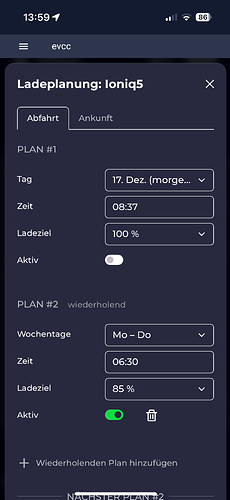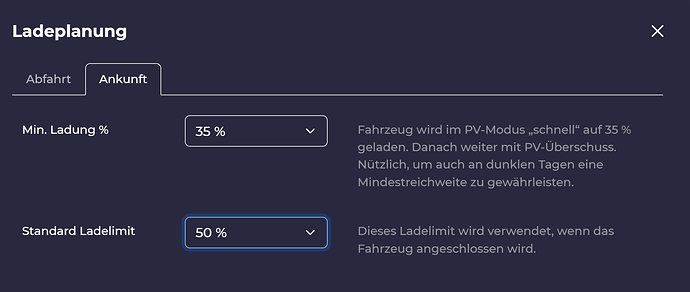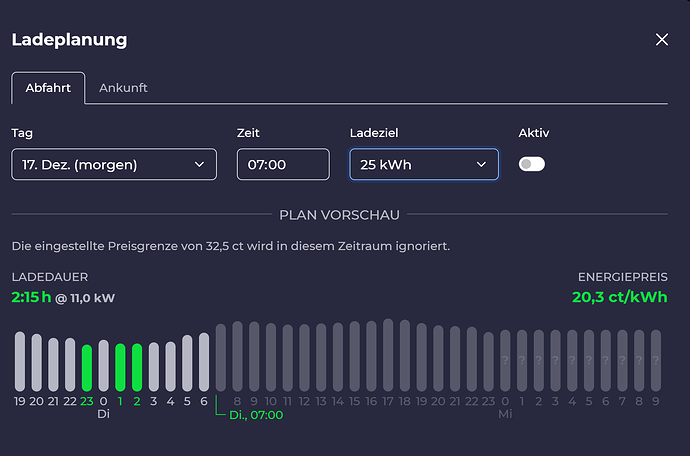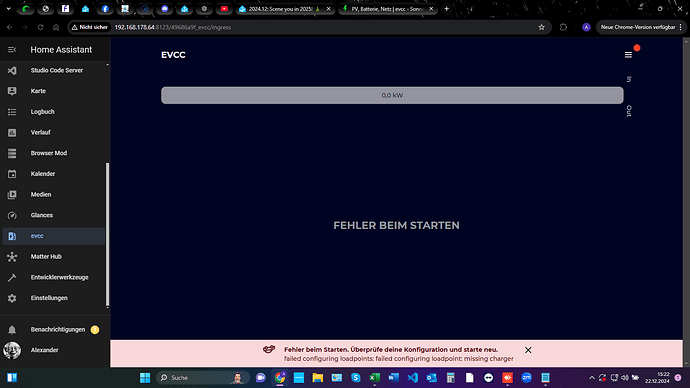Ok, danke.
Wie müsste da meine /evcc.yaml aussehen?
Im Moment sieht sie so aus:
network:
schema is the HTTP schema
setting to https does not enable https, it only changes the way URLs are generated
schema: http
host is the hostname or IP address
if the host name contains a .local suffix, the name will be announced on MDNS
docker: MDNS announcements don’t work. host must be set to the docker host’s name.
host: 192.168.178.64
port is the listening port for UI and
evcc will listen on all available interfaces
port: 7070
interval: 30s # control cycle interval. Interval <30s can lead to unexpected behavior, see interval | evcc - Sonne tanken ☀️🚘
database configuration for persisting charge sessions and settings
database:
type: sqlite
dsn:
sponsor token enables optional features (request at https://sponsor.evcc.io)
sponsortoken:
telemetry enables aggregated statistics
Telemetry allows collecting usage data (grid and green energy, charge power).
Data is aggregated, no individual charging sessions are tracked. The collected,
anonymous data can be retrieved using https://api.evcc.io.
For time being, this is only available to sponsors, hence data is associated with
the sponsor token’s identity.
telemetry: true
log settings
log: info
levels:
site: debug
lp-1: debug
lp-2: debug
cache: error
db: error
modbus proxy for allowing external programs to reuse the evcc modbus connection
each entry will start a proxy instance at the given port speaking Modbus TCP and
relaying to the given modbus downstream device (either TCP or RTU, RS485 or TCP)
modbusproxy:
- port: 5200
uri: solar-edge:502
# rtu: true
# readonly: true # use deny to raise modbus errors
meter definitions
name can be freely chosen and is used as reference when assigning meters to site and loadpoints
meters:
-
name: my_grid
type: template
template: senec-home
usage: grid
host: 192.168.178.10
-
name: my_pv
type: template
template: senec-home
usage: pv
host: 192.168.178.10
-
name: my_battery
type: template
template: senec-home
usage: battery
host: 192.168.178.10
chargers:
vehicle definitions
name can be freely chosen and is used as reference when assigning vehicle to loadpoint
vehicles:
#chargers:
site describes the EVU connection, PV and home battery
site:
title: Home # display name for UI
meters:
grid: my_grid
pv:
- my_pv
battery:
- my_battery
residualPower: 100 # additional household usage margin
maxGridSupplyWhileBatteryCharging: 0 # ignore battery charging if AC consumption is above this value
loadpoint describes the charger, charge meter and connected vehicle
loadpoints:
# remaining settings are experts-only and best left at default values
priority: 0 # relative priority for concurrent charging in PV mode with multiple loadpoints (higher values have higher priority)
soc:
# polling defines usage of the vehicle APIs
# Modifying the default settings it NOT recommended. It MAY deplete your vehicle's battery
# or lead to vehicle manufacturer banning you from API use. USE AT YOUR OWN RISK.
poll:
# poll mode defines under which condition the vehicle API is called:
# charging: update vehicle ONLY when charging (this is the recommended default)
# connected: update vehicle when connected (not only charging), interval defines how often
# always: always update vehicle regardless of connection state, interval defines how often (only supported for single vehicle)
mode: charging
# poll interval defines how often the vehicle API may be polled if NOT charging
interval: 60m
estimate: true # set false to disable interpolating between api updates (not recommended)
enable: # pv mode enable behavior
delay: 1m # threshold must be exceeded for this long
threshold: 0 # grid power threshold (in Watts, negative=export). If zero, export must exceed minimum charge power to enable
disable: # pv mode disable behavior
delay: 3m # threshold must be exceeded for this long
threshold: 0 # maximum import power (W)
tariffs are the fixed or variable tariffs
tariffs:
grid:
type: template
template: tibber
token: 1234
# or variable tariffs
# type: tibber
# token: "1234" # access token
# homeid: "1234" # optional if multiple homes associated to account
# type: awattar
# region: de # optional, choose at for Austria
# charges: # optional, additional charges per kWh
# tax: # optional, additional tax (0.1 for 10%)
# type: octopusenergy
# tariff: AGILE-FLEX-22-11-25 # Tariff code
# region: A # optional
# type: elering # Nordpool
# region: ee # or lt, lv, fi
# charges: # optional, additional charges per kWh
# tax: # optional, additional tax (0.1 for 10%)
# type: energinet # Energinet using the price in DKK
# region: dk1 # or dk2
# charges: # optional, additional charges per kWh
# tax: # optional, additional tax (0.1 for 10%)
# type: entsoe # Entso-E european market data
# domain: BZN|DE-LU # https://transparency.entsoe.eu/content/static_content/Static%20content/web%20api/Guide.html#_areas
# securitytoken: # api token
# charges: # optional, additional charges per kWh
# tax: # optional, additional tax (0.1 for 10%)
# type: pun # PUN - Prezzo unico nazionale - Hourly Italian wholesale prices
# charges: 0 # optional, additional charges per kWh
# tax: 0 # optional, additional tax (0.1 for 10%)
# type: amber
# token: # api token from https://app.amber.com.au/developers/
# siteid: # site ID returned by the API
# channel: general
# type: custom # price from a plugin source; see https://docs.evcc.io/docs/reference/plugins
# price:
# source: http
# uri: https://example.org/price.json
# jq: .price.current
feedin:
# rate for feeding excess (pv) energy to the grid
type: fixed
price: 0.08 # EUR/kWh
# type: octopusenergy
# tariff: AGILE-FLEX-22-11-25 # Tariff code
# region: A # optional
# type: amber
# token: # api token from https://app.amber.com.au/developers/
# siteid: # site ID returned by the API
# channel: feedIn
co2:
# co2 tariff provides co2 intensity forecast and is for co2-optimized target charging if no variable grid tariff is specified
# type: grünstromindex # GrünStromIndex (Germany only)
# zip:
# type: electricitymaps # https://app.electricitymaps.com/map
# uri: <uri>
# token: <token> # needs to be a token with forecast (not in the free tier)
# zone: DE
# type: ngeso # National Grid Electricity System Operator data (Great Britain only) https://carbonintensity.org.uk/
# provides national data if both region and postcode are omitted - Choose ONE only!
# region: 1 # optional, coarser than using a postcode - The region details are at https://carbon-intensity.github.io/api-definitions/#region-list
# postcode: SW1 # optional - Outward postcode i.e. RG41 or SW1 or TF8. Do not include full postcode, outward postcode only
mqtt message broker
mqtt:
broker: localhost:1883
topic: evcc # root topic for publishing, set empty to disable
user:
password:
influx database
influx:
database: evcc
user:
password:
eebus credentials
eebus:
uri: # :4712
interfaces: # limit eebus to specific network interfaces
- en0
certificate: # local signed certificate, required, can be generated via evcc eebus-cert
public: # public key
private: # private key
push messages
messaging:
events:
start: # charge start event
title: Charge started
msg: Started charging in „${mode}“ mode
stop: # charge stop event
title: Charge finished
msg: Finished charging ${chargedEnergy:%.1fk}kWh in ${chargeDuration}.
connect: # vehicle connect event
title: Car connected
msg: „Car connected at ${pvPower:%.1fk}kW PV“
disconnect: # vehicle connected event
title: Car disconnected
msg: Car disconnected after ${connectedDuration}
soc: # vehicle soc update event
title: Soc updated
msg: Battery charged to ${vehicleSoc:%.0f}%
guest: # vehicle could not be identified
title: Unknown vehicle
msg: Unknown vehicle, guest connected?
services:
- type: pushover
app: # app id
recipients:
- # list of recipient ids
- type: telegram
token: # bot id
chats:
- # list of chat ids
- type: email
uri: smtp://:@:/?fromAddress=&toAddresses=
- type: ntfy
uri: https:///
priority:
tags:
Aber ich bekomme das Add-on nicht zum laufen
Liebe Grüße



